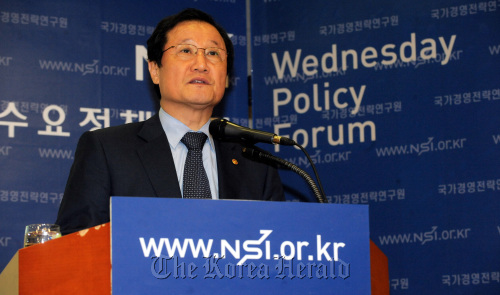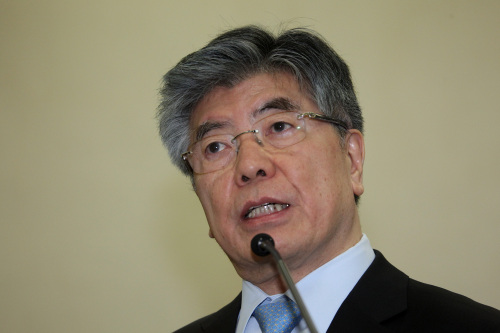BOK officials point to drop in money supply growth to more than 5-year low in January
The Bank of Korea said Wednesday it would focus interest rate policy on firmly securing price stability as Asia’s fourth-largest economy will face upward inflation pressures on both the demand and supply fronts.
The Korean central bank also said in a policy report to parliament that it would continue its effort to diversify investment of the country’s foreign exchange reserves, which hit a record high of $297.67 billion at the end of February.
“(The Bank of Korea) plans to manage the base rate with the focus on firmly securing price stability while helping maintain sound economic growth and taking into account the financial and economic situation at home and abroad,” it said.
The views were largely in line with its policy stance detailed in statements released after it held interest rates steady at its Feb. 11 meeting.
At a separate lecture early on Wednesday, Finance Minister Yoon Jeung-hyun also reaffirmed the government’s resolve to contain inflation, which he said was being lifted by both supply and demand factors.
The Bank of Korea said Wednesday it would focus interest rate policy on firmly securing price stability as Asia’s fourth-largest economy will face upward inflation pressures on both the demand and supply fronts.
The Korean central bank also said in a policy report to parliament that it would continue its effort to diversify investment of the country’s foreign exchange reserves, which hit a record high of $297.67 billion at the end of February.
“(The Bank of Korea) plans to manage the base rate with the focus on firmly securing price stability while helping maintain sound economic growth and taking into account the financial and economic situation at home and abroad,” it said.
The views were largely in line with its policy stance detailed in statements released after it held interest rates steady at its Feb. 11 meeting.
At a separate lecture early on Wednesday, Finance Minister Yoon Jeung-hyun also reaffirmed the government’s resolve to contain inflation, which he said was being lifted by both supply and demand factors.

The central bank has slowly reduced the ratio of U.S. dollar assets in foreign reserves to diversify investment risks but has never disclosed an exact breakdown by currency.
Governor Kim Choong-soo testified at the parliament’s Strategy and Finance Committee just a day before the central bank is due to hold its monthly review of interest rate policy.

Analysts said the central bank is likely to hike the key rate by a quarter percentage point to 3 percent to contain inflation.
“The Korean economy is faced with rising inflationary pressure amid the improvement in the real economy,” the Korea Development Institute said in its monthly report on the latest economic conditions at home and abroad.
The state-run think tank noted both supply and demand factors contribute to applying upward inflationary pressure, mentioning a 4.5 percent jump in consumer prices in February.
The price hikes were mostly prompted by rising oil and commodity prices. Skyrocketing crude prices especially are driving up overall inflationary pressure for Korea, which has to depend on imports for almost all of its energy needs.
Citing the unrest unfolding in the oil-rich Middle East countries and others in North Africa, the KDI expressed concerns that oil price rises are expected to continue and serve as an “uncertainty factor” for some time to come.
But it expected the price hike in crude oil will not continue in the long term considering the production capacity of oil-producing countries.
Korea’s money supply grew at the slowest clip in more than five years in January as the current account surplus sharply narrowed, according to the central bank.
The country’s M2, a narrow measure of its money supply, reached 1,676.4 trillion won ($1.5 trillion) in January, up 6.5 percent from a year earlier.
The January numbers eased from a 7.2 percent gain tallied in December last year and marked the slowest growth since an identical 6.5 percent on-year advance in October 2005.
The M2 covers currency in circulation and all types of deposits with a maturity of less than two years at lenders and non-banking financial institutions, excluding those at insurers and brokerage houses.
“The growth of M2 has been easing as bank lending has not been that brisk and liquidity provided from outside the country has been slowing,” said Kim Byoung-soo, an official at the BOK.
In January, Korea’s current account surplus reached $2.11 billion, the smallest surplus in 11 months, as soaring oil and commodity prices jacked up import bills and overseas travel increased.
The on-year growth in the M2 has been slowing since July last year when the money supply expanded 9.3 percent from the previous year, as banks have been wary of extending corporate loans despite ample liquidity sparked by ultra-low interest rates.
The central bank said in a separate statement that the country’s M2 is presumed to have grown in the mid-5 percent range in February, mainly due to a net outflow of foreign stock and bond money and sluggish lending by savings banks.
Meanwhile, the country’s liquidity aggregate, the broadest measure of the money supply, grew 7.3 percent in January, slowing from a 7.6 percent expansion in December and the lowest expansion since a 6.5 percent gain tallied in March 2005, the BOK said.
The liquidity aggregate covers currency in circulation, all types of deposits at financial institutions, and state and corporate bonds.
(From news reports)








![[Kim Seong-kon] Democracy and the future of South Korea](http://res.heraldm.com/phpwas/restmb_idxmake.php?idx=644&simg=/content/image/2024/04/16/20240416050802_0.jpg&u=)







![[KH Explains] Hyundai's full hybrid edge to pay off amid slow transition to pure EVs](http://res.heraldm.com/phpwas/restmb_idxmake.php?idx=652&simg=/content/image/2024/04/18/20240418050645_0.jpg&u=20240418181020)

![[Today’s K-pop] Zico drops snippet of collaboration with Jennie](http://res.heraldm.com/phpwas/restmb_idxmake.php?idx=642&simg=/content/image/2024/04/18/20240418050702_0.jpg&u=)